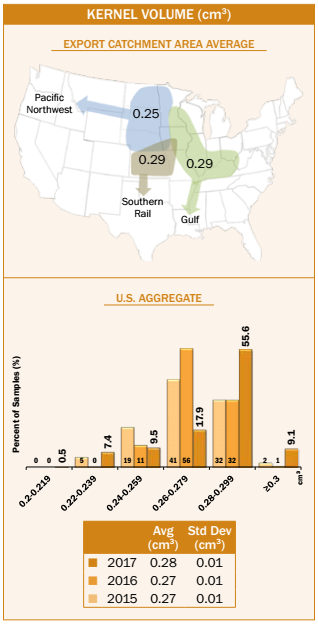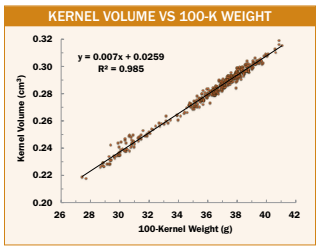Kernel Volume
Kernel volume in cubic centimeters (cm3) is often indicative of growing conditions. Small or round kernels are more difficult to degerm. Additionally, small kernels may lead to increased cleanout losses for processors and higher yields of fiber.
Results
- Average U.S. Aggregate kernel volume (0.28 cm3) was higher than 2016/2017, 2015/2016 and 5YA (all 0.27 cm3).
- Kernel volume range (0.22 to 0.32 cm3) was similar to 2016/2017 (0.24 to 0.31 cm3) and 2015/2016 (0.23 to 0.31 cm3).
- The kernel volume standard deviation (0.01 cm3) was the same as 2016/2017, 2015/2016 and 5YA.
- Average U.S. Aggregate kernel volume at export (0.28 cm3) was lower than at harvest (0.29 cm3) in 2017/2018, but higher than the export and harvest 5YAs (both 0.27 cm3).
- Average kernel volume was smaller for the Pacific Northwest ECA (0.25 cm3) than for the Gulf and Southern Rail ECAs (both 0.29 cm3) in 2017/2018. The Pacific Northwest ECA had either the same or the lowest average kernel volume for 2016/2017, 2015/2016 and 5YA.
- Of the 2017/2018 export samples, 64.7% had kernel volumes equal to or greater than 0.28 cm3, compared with 33% in 2016/2017 and 34% in 2015/2016. This indicates a higher percentage of large kernels in 2017/2018 than in the previous two years.

- There is a positive relationship for the 2017/2018 export corn between kernel volume and 100-kernel weight, as shown in the adjacent figure (the correlation coefficient is 0.99). This indicates that the higher the weight of 100 kernels of corn, the greater the kernel volume.
- Average kernel volume for contracts loaded as U.S. No. 2 o/b (0.28 cm3) was the same as contracts loaded as U.S. No. 3 o/b.
